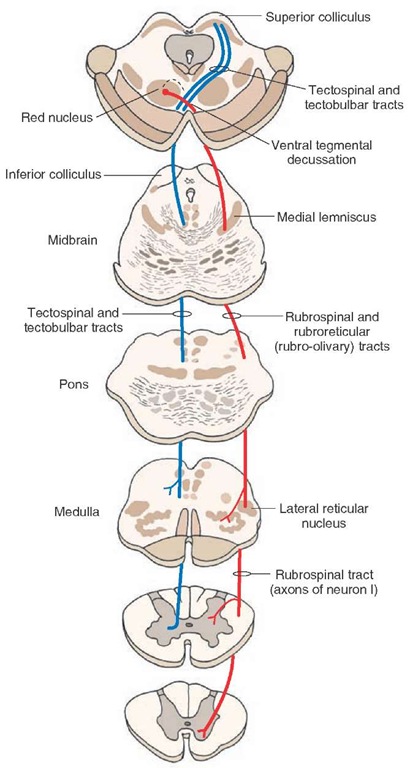Rubrospinal Tract: Difference between revisions
Kate Sampson (talk | contribs) No edit summary |
Kate Sampson (talk | contribs) No edit summary |
||
| Line 24: | Line 24: | ||
- As the Rubrospinal tract recieves afferent fibres from the motor cortex and cerebellum it acts as a non pyramidal route of influencing spinal cord activity through inter and motor neurones <ref name="Crossman" /><ref name="Martinez">Martinez-Lopez1 JE, Moreno-Bravo1 JA, Madrigal1 MP, Martinez1 S, Puelles1 E. Red nucleus and rubrospinal tract disorganization in the absence of Pou4f1. Front. Neuroanat 2015;9:8.</ref> | - As the Rubrospinal tract recieves afferent fibres from the motor cortex and cerebellum it acts as a non pyramidal route of influencing spinal cord activity through inter and motor neurones <ref name="Crossman" /><ref name="Martinez">Martinez-Lopez1 JE, Moreno-Bravo1 JA, Madrigal1 MP, Martinez1 S, Puelles1 E. Red nucleus and rubrospinal tract disorganization in the absence of Pou4f1. Front. Neuroanat 2015;9:8.</ref> | ||
- Excitation of the motor neurones controlling tone of limb flexor muscles<ref name="Crossman" /> | - Excitation of the motor neurones controlling tone of limb flexor muscles and inhibitory to extension during of gait<ref name="Crossman" /><ref name="Kidd">Kidd G, Lawes N, Musa I. Understanding Neuromuscular Plasticity. London: Edward Arnold, 1992.</ref> | ||
- Facilitatory of flexion and inhibitory to extension in cervical and lumbar spine and distal extremity muscles <ref name="Rothwell">Rothwell J. Control of Human Voluntary Movement. London: Chapman & Hall, 1994</ref> | |||
- Neural activity in the red nucleus is related to force, velocity and direction of movement. <ref name="Leonard">Leonard CT. The Neuroscience of Human movement. St Louis:Mosby 1998</ref> | - Neural activity in the red nucleus is related to force, velocity and direction of movement. <ref name="Leonard">Leonard CT. The Neuroscience of Human movement. St Louis:Mosby 1998</ref> | ||
Revision as of 00:26, 1 April 2016
Original Editor - Your name will be added here if you created the original content for this page.
Lead Editors - Kate Sampson, Lucinda hampton, Evan Thomas, Wendy Walker, WikiSysop and Kim Jackson
Description[edit | edit source]
The Rubrospinal tract is a descending pathway which originates in the Red Nucleus and descends to the spinal cord.[1]
Anatomy[edit | edit source]
Origin[edit | edit source]
- The Red Nucleus of the midbrain tegmentum [1]
Course / Path[edit | edit source]
- Fibres pass ventromedially and cross the ventral tegmental decussation.
- Fibres descend to the spinal cord where they lie ventrolateral to and intertwined with the corticospinal tract.
Function[edit | edit source]
- As the Rubrospinal tract recieves afferent fibres from the motor cortex and cerebellum it acts as a non pyramidal route of influencing spinal cord activity through inter and motor neurones [1][2]
- Excitation of the motor neurones controlling tone of limb flexor muscles and inhibitory to extension during of gait[1][3]
- Facilitatory of flexion and inhibitory to extension in cervical and lumbar spine and distal extremity muscles [4]
- Neural activity in the red nucleus is related to force, velocity and direction of movement. [5]
Pathology[edit | edit source]
Damage to the Rubrospinal pathway can result in
Prognosis[edit | edit source]
Resources[edit | edit source]
Recent Related Research (from Pubmed)[edit | edit source]
References[edit | edit source]
- ↑ 1.0 1.1 1.2 1.3 Crossman AR, Neary D. Neuroanatomy: An Illustrated Colour Text. Third Edition. London: Elsevier, 2004
- ↑ Martinez-Lopez1 JE, Moreno-Bravo1 JA, Madrigal1 MP, Martinez1 S, Puelles1 E. Red nucleus and rubrospinal tract disorganization in the absence of Pou4f1. Front. Neuroanat 2015;9:8.
- ↑ Kidd G, Lawes N, Musa I. Understanding Neuromuscular Plasticity. London: Edward Arnold, 1992.
- ↑ Rothwell J. Control of Human Voluntary Movement. London: Chapman & Hall, 1994
- ↑ Leonard CT. The Neuroscience of Human movement. St Louis:Mosby 1998







